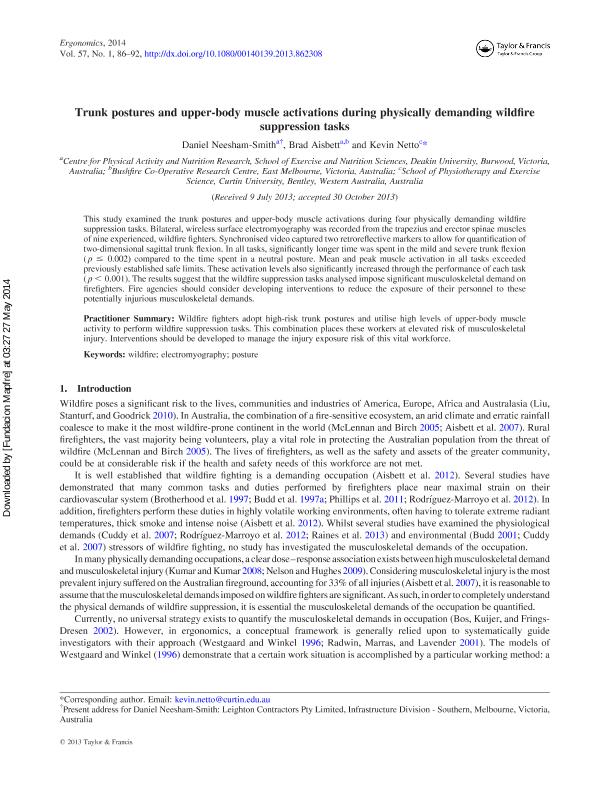Trunk postures and upper-body muscle activations during physically demanding wildfire suppression tasks

Contenido multimedia no disponible por derechos de autor o por acceso restringido. Contacte con la institución para más información.
| Tag | 1 | 2 | Value |
|---|---|---|---|
| LDR | 00000cab a2200000 4500 | ||
| 001 | MAP20140019113 | ||
| 003 | MAP | ||
| 005 | 20140530130415.0 | ||
| 008 | 140527e20140106esp|||p |0|||b|spa d | ||
| 040 | $aMAP$bspa$dMAP | ||
| 084 | $a875 | ||
| 100 | 1 | $0MAPA20140009374$aNeesham-Smith, Daniel | |
| 245 | 1 | 0 | $aTrunk postures and upper-body muscle activations during physically demanding wildfire suppression tasks$cDaniel Neesham-Smith, Brad Aisbett, Kevin Netto |
| 520 | $aThis study examined the trunk postures and upper-body muscle activations during four physically demanding wildfire suppression tasks. Bilateral, wireless surface electromyography was recorded from the trapezius and erector spinae muscles of nine experienced, wildfire fighters. Synchronised video captured two retroreflective markers to allow for quantification of two-dimensional sagittal trunk flexion. In all tasks, significantly longer time was spent in the mild and severe trunk flexion (p = 0.002) compared to the time spent in a neutral posture. Mean and peak muscle activation in all tasks exceeded previously established safe limits. These activation levels also significantly increased through the performance of each task (p < 0.001). The results suggest that the wildfire suppression tasks analysed impose significant musculoskeletal demand on firefighters. Fire agencies should consider developing interventions to reduce the exposure of their personnel to these potentially injurious musculoskeletal demands. | ||
| 773 | 0 | $wMAP20100019818$tErgonomics : the international journal of research and practice in human factors and ergonomics$dOxon [United Kingdom] : Taylor & Francis, 2010-$x0014-0139$g06/01/2014 Volumen 57 Número 1 - enero 2014 |

